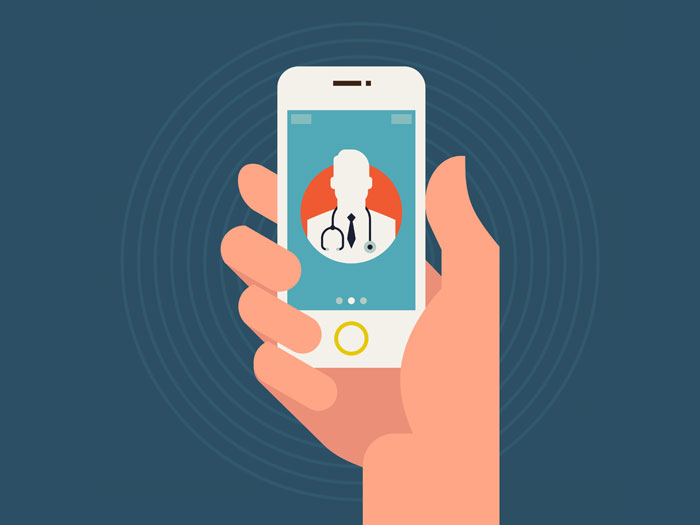Sponsored Content by CorVel
Telehealth: The Wait is Over
From Early Intervention To Immediate Intervention
Reducing medical lag times and initiating early intervention are some of the cornerstones to a successful claims management program. A key element in refining those metrics is improving access to appropriate care.
Telehealth is the use of electronic communications to facilitate interaction between a patient and a physician. With today’s technology and mass presence of mobile devices, injured workers can be connected to providers instantaneously via virtual visits. Early intervention offers time and cost saving benefits, and emerging technology presents the capability for immediate intervention.
Telehealth creates an opportunity to reduce overall claim duration by putting an injured worker in touch with a doctor including a prescription or referral to physical therapy when needed. On demand, secure and cost efficient, telehealth offers significant benefits to both payors and patients.
The Doctor Will See You Now
Major healthcare players like Aetna and Blue Cross Blue Shield are adding telehealth as part of their program standards. This comes as no surprise as multiple studies have found a correlation between improved outcomes and patients taking responsibility for their treatment with communications outside of the doctor’s office. CorVel has launched the new technology within the workers’ compensation industry as part of their service offering.
“Telehealth is an exciting enhancement for the Workers’ Compensation industry and our program. By piloting this new technology with CorVel, we hope to impact our program by streamlining communication and facilitating injured worker care more efficiently,” said one of CorVel’s clients.
“We expect to add convenience for the injured worker while significantly reducing lag times from the injury to initiating treatment. The goal is to continue to merge the ecosystems of providers, injured workers and payors.”
— David Lupinsky, Vice President, Medical Review Services, CorVel Corporation
As with all new solutions, there are some questions about telehealth. Regarding privacy concerns, telehealth is held to the same standards of HIPAA and all similar rules and regulations regarding health information technology and patients’ personal information. Telehealth offers secure, one on one interactions between the doctor and the injured worker, maintaining patient confidentiality.
The integrity of the patient-physician relationship often fuels debates against technology in healthcare. Conversely, telehealth may facilitate the undivided attention patients seek. In office physicians’ actual facetime with patients is continually decreasing, citing an average of eight minutes per patient, according to a 2013 New York Times article. Telehealth may offer an alternative.
Virtual visits last about 10 to 15 minutes, offering more one on one time with physicians than a standard visit. Patients also can physically participate in the physician examination. When consulting with a telehealth physician, the patient can enter their vital signs like heart rate, blood pressure, and temperature and follow physical cues from the doctor to help determine the diagnosis. This gives patients an active role in their treatment.
Additionally, a 2010 BioMed Central Health Services Research Report is helping to dispel any questions regarding telehealth quality of care, stating “91% of health outcomes were as good or better via telehealth.”
Care: On Demand
By leveraging technology, claims professionals can enhance an already proactive claims model. Mobile phones and tablets provide access anywhere an injured worker may be and break previous barriers set by after hours injuries, incidents occurring in rural areas, or being out of a familiar place (i.e. employees in the transportation industry).
With telehealth, CorVel eliminates travel and wait times. The injured worker meets virtually with an in-network physician via his or her computer, smart phone or tablet device.
As most injuries reported in workers’ compensation are musculoskeletal injuries – soft tissue injuries that may not need escalation – the industry can benefit from telehealth since many times the initial physician visit ends with either a pharmacy or physical therapy script.
In CorVel’s model, because all communication is conducted electronically, the physician receives the patient’s information transmitted from the triage nurse via email and/or electronic data feeds. This saves time and eliminates the patient having to sit in a crowded waiting room trying to fill out a form with information they may not know.
Through electronic correspondence, the physician will also be alerted that the injured worker is a workers’ compensation patient with the goal of returning to work, helping to dictate treatment just as it would for an in office doctor.
In the scope of workers’ compensation, active participation in telehealth examinations, accompanied by convenience, is beneficial for payors. As the physician understands return to work goals, they can ensure follow up care like physical therapy is channeled within the network and can also help determine modified duty and other means to assist the patient to return to work quickly.

Convenience Costs Less
Today, convenience can often be synonymous with costly. While it may be believed that an on demand, physician’s visit would cost more than seeing your regular physician; perceptions can be deceiving. One of the goals of telehealth is to provide quality care with convenience and a fair cost.
Telehealth virtual visits cost on average 30% less than brick and mortar doctor’s office visits, according to California state fee schedule. In addition, “health plans and employers see telehealth as a significant cost savings since as many as 10% of virtual visits replace emergency room visits which cost hundreds, if not thousands, of dollars for relatively minor complaints” according to a study by American Well.
“Telehealth is an exciting enhancement for the Workers’ Compensation industry and our program. By piloting this new technology with CorVel, we hope to impact our program by streamlining communication and facilitating injured worker care more efficiently,” said one of CorVel’s clients.
Benefits For All
Substantial evidence supports that better outcomes are produced the sooner an injured worker seeks care. Layered into CorVel’s proactive claims and medical management model, telehealth can upgrade early intervention to immediate intervention and is crucial for program success.
“We expect to add convenience for the injured worker while significantly reducing lag times from the injury to initiating treatment,” said David Lupinsky, Vice President, Medical Review Services.
“The goal is to continue to merge the ecosystems of providers, injured workers and payors.”
With a people first philosophy and an emphasis on immediacy, CorVel’s telehealth services reduce lag time and connect patients to convenient, quality care. It’s a win-win.











